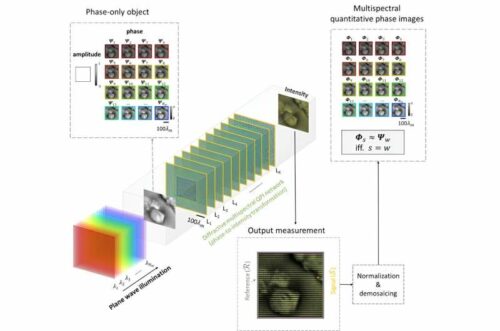Discover the world of label-free imaging with Quantitative Phase Imaging (QPI), explore spatial refractive index variations, deep learning-enhanced designs, and the potential for compact, high-performance multispectral phase imaging systems.

Quantitative Phase Imaging (QPI) is an imaging method that doesn’t require labelling and uses clear samples’ optical path length data to assess their distribution of refractive index and changes in thickness. Systems of multispectral QPI further this concept by taking numerous phase images over different spectral ranges. Such capabilities allow for examining the spatial variations in refractive index and dispersion properties in transparent specimens like cells.
A group of researchers guided by Professor Aydogan Ozcan from the Electrical and Computer Engineering Department at UCLA unveiled a multispectral QPI blueprint. This setup taps into the power of deep learning to create a wide-ranging diffractive optical network, which facilitates the capture of quantitative phase images over multiple spectral bands in a singular snapshot. This employs numerous spatially arranged dielectric diffractive layers, each featuring hundreds of thousands of transmissive elements optimised through deep learning.
Following the assembly of the ensuing diffractive layers, the optical network operates as a comprehensive optical phase-to-intensity converter, isolating the phase outlines of the input subjects at preset wavelengths. This is achieved by directing the multispectral QPI signals to assigned spatial locales on the output plane. Here, a single-colour focal plane array gauges the subsequent intensity patterns. Within this array, the pixel sections within the signal area are intermingled, with each cluster analysing the QPI signal linked to a distinct desired spectral band.
The group carried out numerical simulations to demonstrate the effectiveness of their diffractive multispectral quantitative phase imaging device. They exhibited the system’s ability to execute QPI concurrently across 16 unique spectral bands within the visible light spectrum while sustaining uniform efficiency across all wavelengths. The robustness and adaptability of their diffractive phase imager design were affirmed through successful imaging trials on previously unobserved object types, including human cell imagery. These numerical studies highlight the system’s potential versatility, positioning it as a multi-purpose multispectral quantitative phase imager apt for various applications. The processors employed in these diffractive multispectral QPIs hold promise for amalgamation with monochromatic optoelectronic sensor arrays that span various spectral zones. This cohesive system could pave the way for developing compact yet high-efficiency multispectral phase imaging setups. These systems could potentially cater to biomedical imaging, materials science, and environmental surveillance applications.





